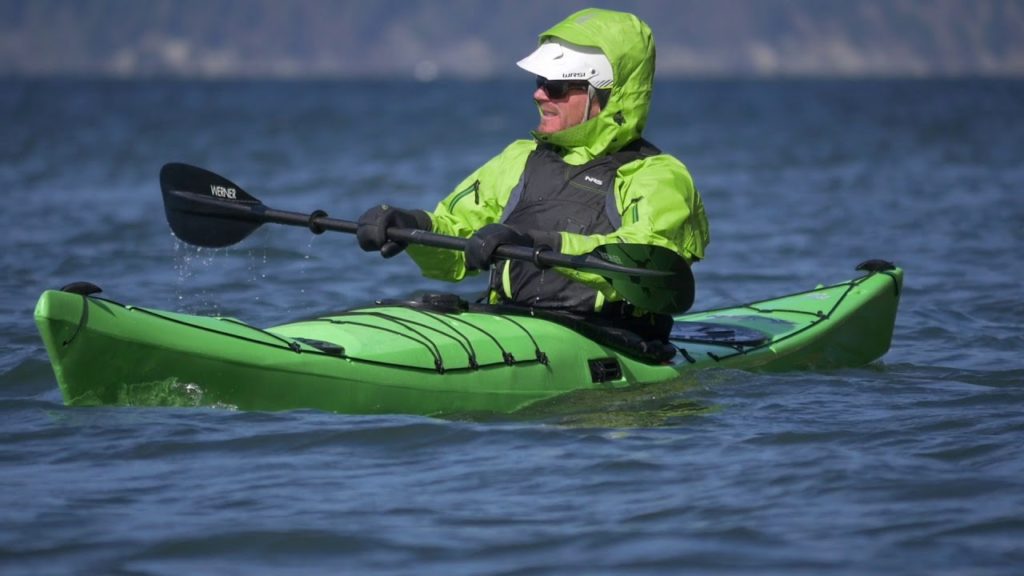 This guide will take you through six of the best drysuits available for kayaking to keep you warm, dry, and still able to maneuver with ease. Next, you’ll get a comprehensive buyer’s guide to help guide you through selecting the very best drysuit for your cold water sports needs. To wrap things up, a detailed comparison of wetsuits and drysuits will arm you with the knowledge that you need to keep you warm and comfortable no matter what the weather and water may throw at you.
This guide will take you through six of the best drysuits available for kayaking to keep you warm, dry, and still able to maneuver with ease. Next, you’ll get a comprehensive buyer’s guide to help guide you through selecting the very best drysuit for your cold water sports needs. To wrap things up, a detailed comparison of wetsuits and drysuits will arm you with the knowledge that you need to keep you warm and comfortable no matter what the weather and water may throw at you.
Reviews of the Top Six Drysuits
1. NRS Pivot Drysuit
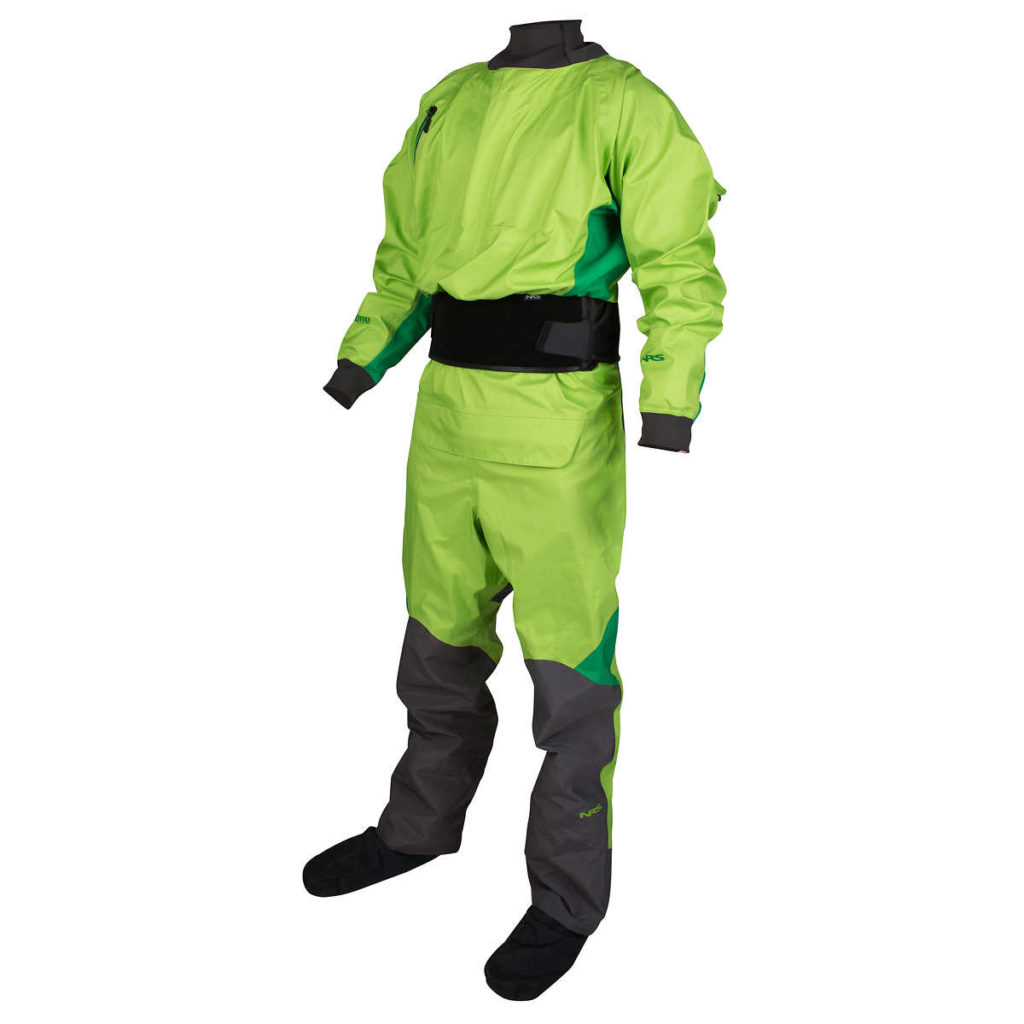
The NRS Pivot Drysuit was created with comfort and durability in mind. This drysuit placed the ZIPIT MasterSeal zipper on the back to reduce the risk of creating pressure points. This increases the longevity of the suit and can still maintain great mobility when wearing the suit. Made up of four layers, this suit gives you a waterproof unit that’s breathable and also easy to move in. Built-in, waterproof socks help you to stay dry from your neck to your toes. It even plays nicely with a kayak’s spray skirt to keep water out of the cockpit and you warm on a chilly day.
Key Features:
- This suit is composed of Eclipse fabric that has four layers for protection and strength. The unique, patented outer layer has a Nanosphere DWR finish to lock water out. It also moves easily and smoothly so that you can paddle or move without pilling the fabric or creating friction.
- The suit is designed to be tough and resistant to punctures for years of outdoor fun with cold water sports.
- There are attached dry socks that are also made of 125 denier Eclipse fabric to keep your toes warm and waterproof throughout your adventures. For added durability, the toes and heels have been reinforced, and each seam has been waterproofed.
- The entry zipper is located on the back of the suit to let you move easier and to reduce the stress placed on the zipper. Its unique design allows you to take the suit on and off without assistance.
- The relief zipper is a MasterSeal Zipit zipper that is easy to operate and has a waterproof seal. It also has a flap cover, and every component makes it simple for you to take care of your business without having to completely remove the suit.
- The openings at the wrists and neck are made of high-quality latex gaskets to create snug, waterproof seals. The neck, wrists, and ankles of the suit also have volcano-style, Neoprene overcuffs that drain automatically and are puncture resistant.
- The legs of the suit have been thoroughly tested to withstand water and rugged conditions. The seat and legs have an additional layer of Eclipse fabric for added strength, and the legs sport only one seam for increased mobility and decreased risk of pressure points.
- If you’re using a kayak, the overskirt incorporates seamlessly into your spray skirt to keep water out of your boat. There is a Neoprene band that is five inches wide and a hook-and-loop, double-pull system to hug the sprayskirt and create a waterproof seal.
2. NRS Women’s Crux Drysuit
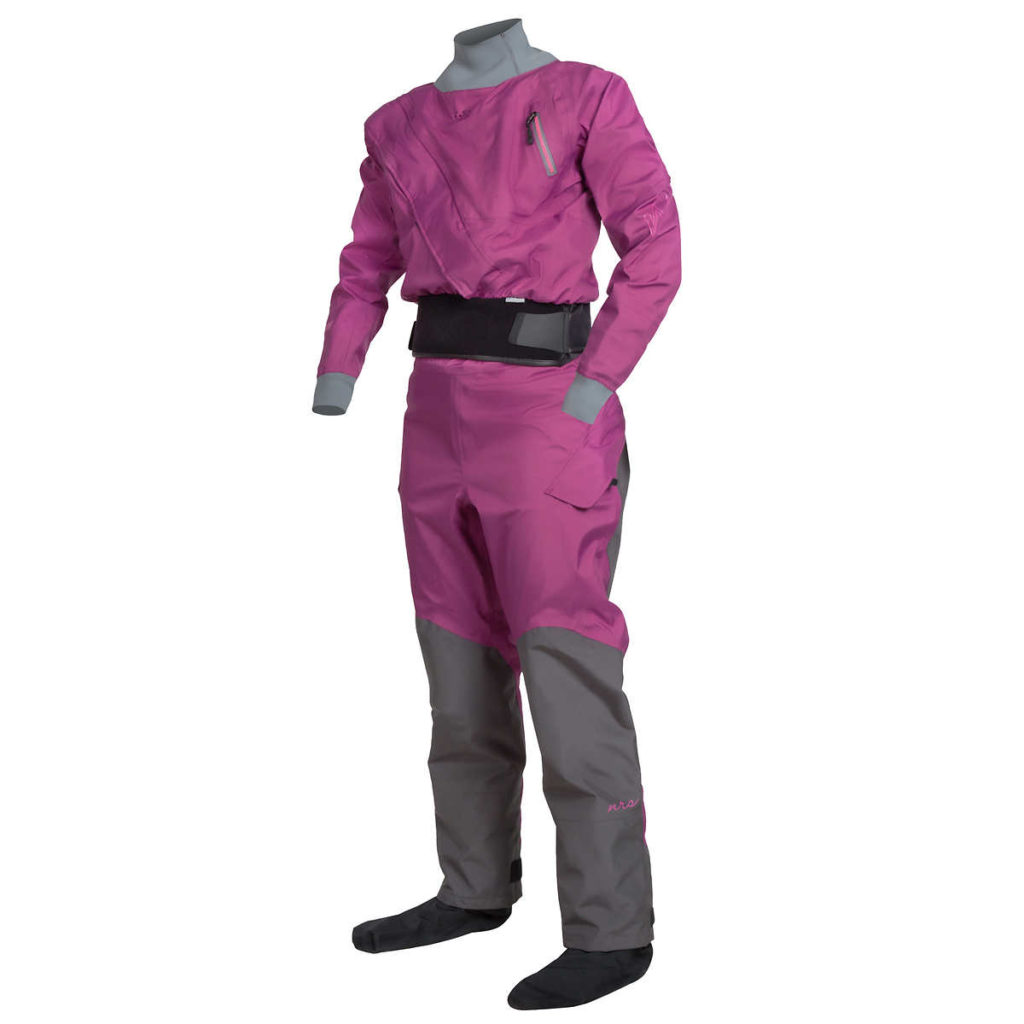
The NRS Women’s Crux Drysuit is ideal for the sportswoman on the go. Composed of a four-layer, resilient Eclipse fabric, this suit will keep up with your cold water sports adventures to help you stay warm and dry the whole time. The zippers have a protective overlay to reduce stress along the zipper itself and add to its waterproofing. The reinforced legs and seat mean that even if you take a tumble, your drysuit will resist punctures and damage. The details of the suit were designed specifically for women to get a better fit for females.
Key Features:
- The drysuit is composed of Eclipse fabric that has four layers of protection for the ultimate, durable suit. There is a proprietary barrier that makes the suit both waterproof and breathable, and a Nanosphere DWR coating keeps fresh or salt water out. The outer shell is a polyester microfiber with a smooth finish that won’t create friction as you paddle and play yet is also puncture-resistant.
- To keep water out, the attached drysocks are composed of 125 denier Eclipse fabric with reinforced seams at the toes and heels.
- You’ve got maximum protection with the latex gasket openings at the arms and neck. For further waterproof coverage, there are Neoprene, volcano-style overcuffs at the neck, wrists, and ankles. They are also self-draining to let the water slide off your arms just like it does off a duck’s back.
- The zippers are MasterSeal, Zipit style for extra durability and waterproofing. The relief flap has a hook-and-loop seal that’s easy to use when nature calls but tightly seals when you’re done with your business.
- The legs and seat of the suit have additional reinforcements so that your suit can handle anything the riverbed or ocean tries to throw at it. There’s also a single leg seam to decrease possible pressure points.
- A five-inch Neoprene overlay at the waist allows you to connect your drysuit seamlessly into the spray skirt of a kayak for the ultimate waterproof cockpit.
3. Kokatat Men’s Gore-Tex Icon Drysuit Leaf
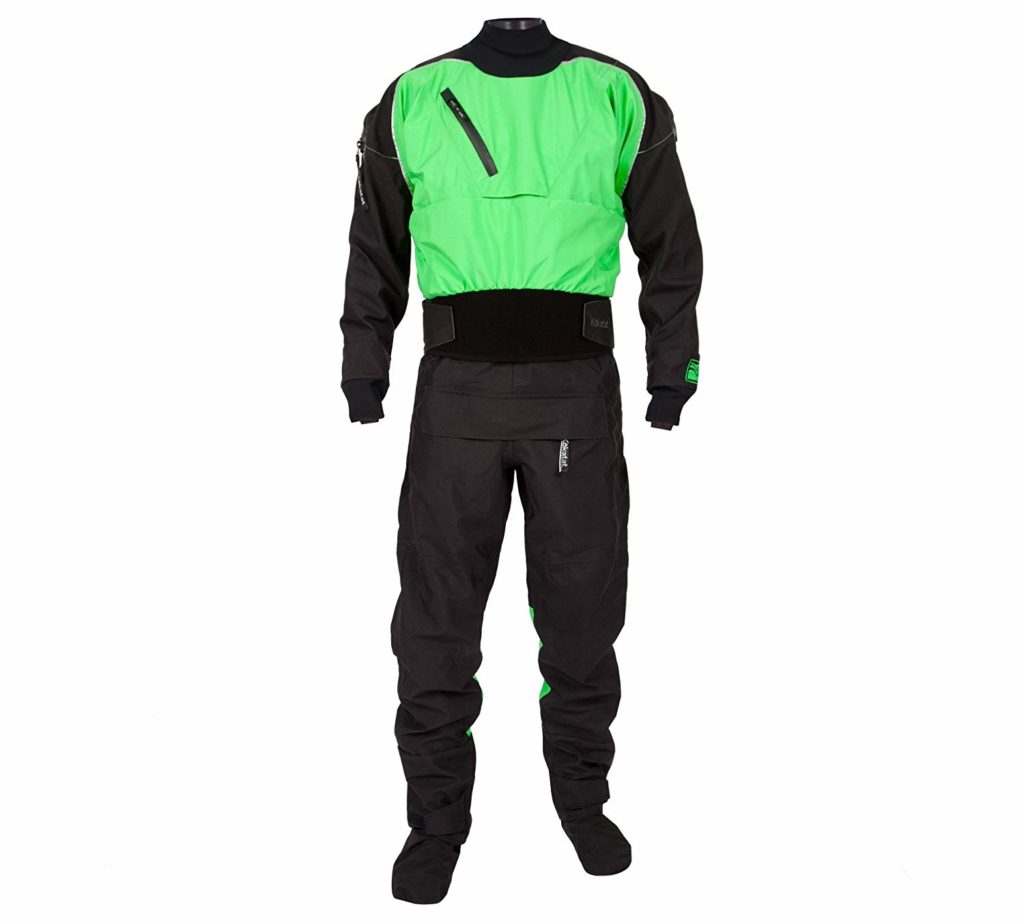
The Kokatat Men’s Gore-Tex Icon Drysuit Leaf is the ideal choice to keep you toasty and dry in chilly temperatures. This sturdy drysuit is specially designed with a three-layer Gore-Tex Pro exterior to repel water, an Evolution nylon body, and strong Cordura Gore-Tex for the shoulders, arms, and legs. This combination can withstand any rough and tumble conditions that might dump you on your hands and knees while still keeping the water out of your suit. Neoprene neckline and cuffs keep things practically airtight so that the water stays where it’s supposed to and not snuggled in next to you.
Key Features:
- This drysuit is covered in a three-layer Gore-Tex Pro laminate to keep the water from seeping into your suit.
- The neck and wrist gaskets are made of latex to create a waterproof seal.
- The neckband can be adjusted and trimmed down to your specifications for a custom fit to offer you maximum protection from the water.
- There are Neoprene over-cuffs at the neck and wrists to prevent water from entering at these points.
- The 330 Cordura Gore-Tex at the shoulders, arms, and knees gives you further protection from the water and has additional strength so that you won’t ruin the suit even if you find yourself crawling to shore after a spill.
- There are Gore-Tex socks incorporated into the suit itself to keep your toes warm and dry throughout your cold weather voyage.
- There’s a Neoprene overskirt that is dual-adjustable to interlock with your spray skirt’s hooks and loops. This can keep the cockpit of your kayak nice and dry.
- The front relief zipper lets you relieve yourself quickly and discreetly without having to remove the entire suit.
4. Level Six Emperor 3.0 Ply Drysuit
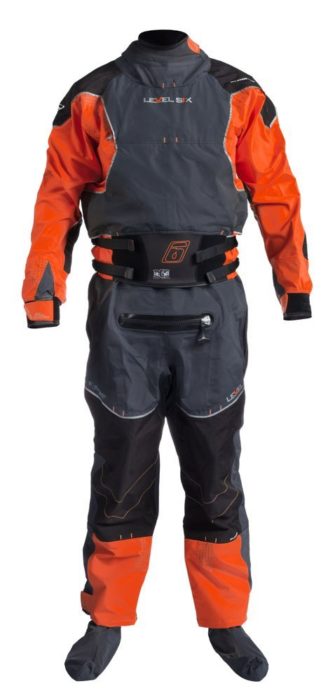
The Level Six Emperor 3.0 Ply Drysuit is a fantastic choice to let you enjoy cold water sports without getting soggy or hypothermia. This suit is designed to be water-tight, durable, and breathable, and it was created with input from top professional paddlers. Resilient CorduraAr panels line the knees, elbows, bottom, forearms, and shoulders of this drysuit to reinforce the areas that take the most wear and tear if you take a tumble. This suit was designed with your maximum mobility in mind so that you can move easily and still stay protected. It offers a wide variety of features with your comfort in mind, including a key pocket that can be accessed even when your life jacket is on and fleece-lined pockets to warm your hands on chilly days.
Key Features:
- The drysuit is waterproof, and it’s also designed to be breathable and durable for years of use.
- Created with mobility in mind, this drysuit has a TIZIP entry zipper across the shoulders. It will keep the water out with its waterproof seal and still allow you to manipulate a paddle easily. The spine of the suit also articulates to let you move freely.
- CorduraAr panels line the shoulders, elbows, forearms, knees, and bottom to give you extra reinforcement for minimal wear on these high-stress areas.
- The neck and wrist closures have latex gaskets that adjust with a hook and loop for a secure fit to keep the water out where it belongs instead of next to your skin.
- This suit features hook-and-look overcuffs at the ankles to keep out debris and water. Three-ply eXhaust socks are incorporated into the suit to keep all of your toes dry all day long.
- The TIZIP relief zipper is easy to use and conveniently located so that you can do your business and be on your way quickly.
- To keep the cockpit of your kayak dry, simply use the double-tunnel that overlaps with the Dual Cinch System around the waist to connect with your spray skirt. This helps to keep the water in the river and not in your kayak.
- This drysuit has incorporated several features for additional comfort and safety. There is a small pocket in the chest that has a waterproof zipper and can still be accessed while wearing your life jacket. This pocket has a safety whistle in case you get into trouble and a small key pocket for your convenience. You’ll also love the hand-warmer pockets that are lined with fleece and perfect for chilly days.
- This drysuit comes highly recommended and with a robust warranty so that you can buy with confidence. Previous buyers have reported that they have been using this suit for five years, and it is still going strong. The manufacturer offers a one-year guarantee with each purchase.
5. Stohlquist Amp Drysuit with Tunnel Drysuit
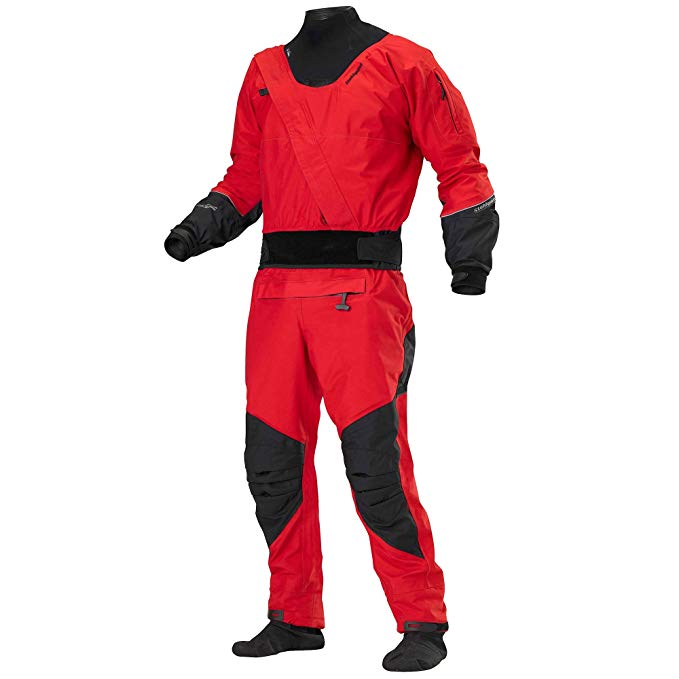
The Stohlquist Amp Drysuit with Tunnel Drysuit is a waterproof yet breathable drysuit with a comfortable fit that gives you reliable protection from the elements. Made of a four-layer fabric called the “Twin Sensor” paired with a heavy-duty nylon outer shell, this suit was created to keep you dry all day long. Latex neck and cuff gaskets with built-in UV protection will keep the water and sunlight out while giving you long-lasting flexibility without tearing. The suit includes fabric socks to keep your feet dry and comfortable throughout your adventure.
Key Features:
- The suit is composed of four layers to keep you dry but also allows you to move with ease. The nylon outer layer has a DWR coating, and the layer consists of a hydrophobic, microporous PU coating. Next, the hydrophilic, laminate membrane and the nylon tricot lining keep the suit breathable and comfortable.
- The MasterSeal zippers are waterproof and effortless to use. There is a relief zipper that makes it easy to answer nature’s call, and the entry zipper is located across the chest to make it simple to put on or take off by yourself.
- The Duraseal neck and wrist gaskets are coated with Neoprene for a snug fit to repel water, and the wrist over-cuffs provide additional insurance against water entry. The Neoprene also offers UV coverage and decreases the risk of tearing the suit.
- The knees and seat of this suit are reinforced with Cordura to let it take a beating and still last through many cold water trips. The knees of this drysuit articulate for better movement and come with mesh drainers.
- This suit was designed with your comfort and use in mind with two exterior pockets that are easy to access on the arm and leg.
- It’s simple to integrate this suit with the spray skirt of a kayak with the double-tunnel system at the waist.
- There are reflective arm panels to keep you safe no matter what time of day you find yourself out on the water.
6. O’Neill Men’s Boost 300g Drysuit
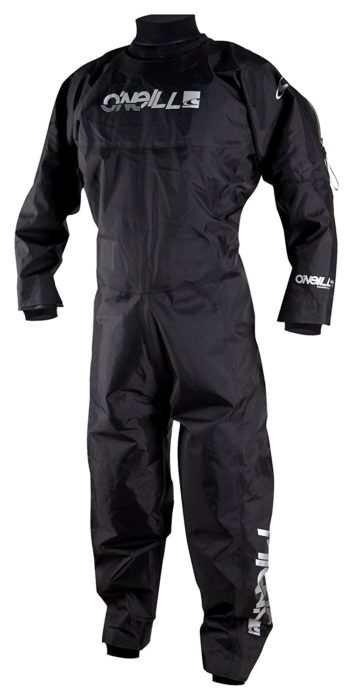
The O’Neill Men’s Boost 300g Drysuit is a breathable, nylon suit that is a great way to stay dry and cozy while out conquering a cold water sport. The trilaminate, nylon shell is resistant to scratches and punctures even if things get a little rough and tumble. It weighs a mere 300 grams per square inch to get you lightweight protection that won’t weigh you down. This suit offers the unique feature of suspenders built right into the inside of the suit to help you get the perfect fit for you. This also makes it easy for you to share the suit with a friend if desired. Specialized, waterproof tape lines the seams to keep water out and warmth in.
Key Features:
- This suit features a nylon shell of sturdy trilaminate material to keep you dry while taking a beating. The material was created to hold up to rigorous conditions and resist ripping or tearing. Additionally, the lightweight material of this suit won’t slow you down as you maneuver the open seas.
- This drysuit has latex ankle and wrist seals that were designed to be thicker than other drysuits for extra protection from water creeping in at the openings of the suit.
- There is plenty of room underneath the suit to allow you to layer this with a wetsuit or warm layers underneath. It also has suspenders to help you get an ideal fit for your body shape.
- The SmoothSkin Dry Neck Seal will keep water out without chafing your neck for a tight, comfortable fit.
- All of the seams of the suit have been reinforced with waterproof tape for added defense against water entering the suit.
- This suit features a waterproof zipper across the back to keep the zipper from getting in your way when you’re kayaking or sailing in cold weather.
- O-Neill stands behind their craftsmanship and offers a limited warranty for one year to give you added confidence when buying this suit.
The Ultimate Drysuit Buyer’s Guide
You’ve been looking forward to this moment all week long. You’ve cleared your schedule to get out to your favorite spot, you’re finally out on the water, and you’re ready to enjoy a chilly, refreshing day out in nature doing your favorite cold water sport. Yet, somehow you manage to get a little bit wet, and with the cooler temperatures, that wet spot can keep you chilled and uncomfortable all day long. For colder days, it’s best to invest in a wetsuit, drysuit, or both to keep you comfortable and protected no matter what Mother Nature throws at you.
Staying dry and warm is important for kayaking or other cold water sports in any weather. A drysuit is the ideal piece of equipment to add to your kayaking outfit for protection from the elements. A drysuit is specially designed to live up to its name and keep you completely dry while out on the water. It typically has a gasket at each opening to keep water out and warmth in. Unlike a wetsuit which allows a thin layer of water into the suit, a drysuit is intended to be fully waterproof and can reduce your risk of developing hypothermia.
There are several important things to keep in mind when selecting the right drysuit for you. You should always consider the fit of the suit, its material, its zippers, possible attached socks, and more.
Fit
The fit of a drysuit is one of the first places to start your process of picking the best one for your needs. Drysuits can have different features for male versus female adventurers, so this can be an important thing to consider. Some drysuits also include built-in suspenders to help you get a custom fit to keep your suit close for better mobility. Additionally, it’s important to have enough room underneath the suit for a sufficient number of layers to keep you warm on chilly days. Be sure to study the sizing charts to be able to choose the ideal size for your shape, and using your shirt size can be a good starting point for size selection.
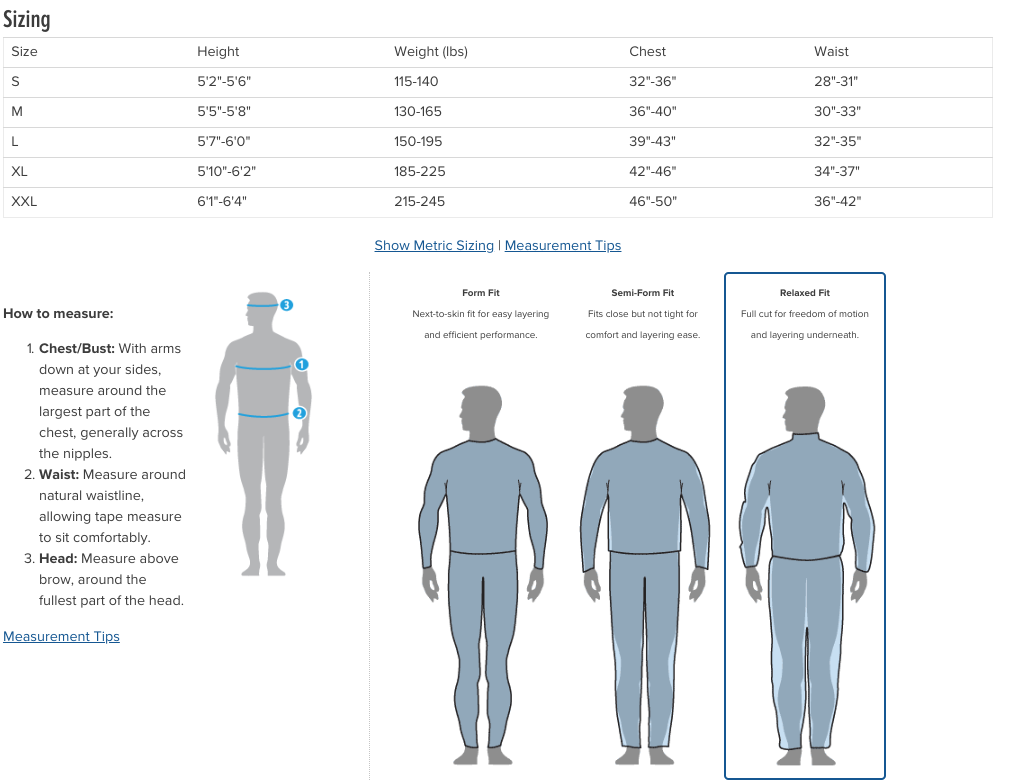
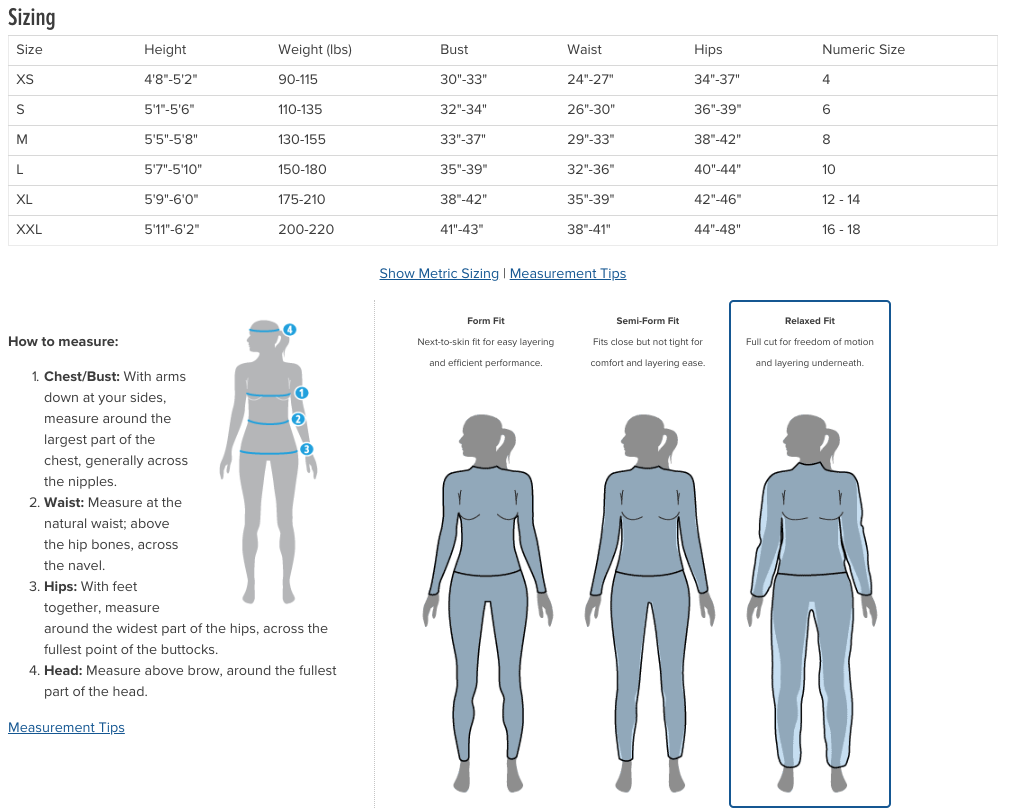
Material and Ability to Breathe
The material of your drysuit and its ability to breathe can play a role in the longevity and comfort of your suit. Most drysuits are made of a long-lasting, heavy-duty Gore-Tex fabric that is resistant to scrapes and tears. However, some lighter materials may cost less, but please be aware that they may be more susceptible to wear and tear. Also, keep in mind if your favorite drysuit has reinforcements on the seat and legs of the suit, which can help the fabric to survive more scrapes.
Breathable fabrics also help to reduce your risk of sweating, which is an important consideration for cold water sports. If the fabric is too restrictive and causes you to sweat, then you run a higher risk of developing hypothermia.
Zippers
The placement of the entry zipper should be a factor in selecting your drysuit. Entry zippers can be located on the front or back of the trunk of the drysuit. Zippers placed across the chest can make getting into the suit without help easier than those with zippers on the back. However, zippers located on the back of the suit may experience less tension and stress. Keeping in mind how you usually need to maneuver when wearing the suit can help you pick up the best style for you.
Relief zippers are designed to let you use the restroom without having to struggle in and out of your drysuit every time. You’ll stay warmer and take care of business quicker. It can be an important thing to invest in a suit that’s gender appropriate for you, as a women’s suit tends to have a drop-seat and a men’s may only have a front zipper. With whichever suit you choose, it’s important to get one that has a waterproof zipper with a rubberized or sealed seam to keep chilly river water away from your nether regions.
Socks
Keeping your feet warm and dry is essential for cold water sports. Be sure to check if your potential drysuit has attached socks or not. For suits with attached socks, make sure that it has Gore-Tex or another resilient material. Reinforcements along the seams can be particularly helpful to keep them waterproof and going for the long haul. If the suit does not have attached socks, this can be a potential spot for water to creep into the suit. You may also wish to wear water shoes over the drysuit as an added layer of protection from punctures or tearing the suit.
Special Features
Look carefully at the neckline and cuffs of a drysuit to pick out the correct one for your cold water sport needs. Neoprene openings have the potential to let a small amount of water trickle in occasionally, so this may be a better option for an activity like fishing where there is less of a risk of you ending up in the water. For sports like kayaking or windsurfing, you may do better to purchase a suit with latex gasket closures at the neckline and cuffs, which tend to be more waterproof.
You should also decide what type of waistline you need in a drysuit. If you plan to use the drysuit while kayaking, it can be extremely helpful if the suit has a tunnel or waistband that can connect with your spray skirt. This can help to keep water out of the cockpit of your kayak to keep you warmer and more comfortable on your trip. Some drysuits create a better seal than others.
If you’re looking for maximum comfort while out on the open water, you should look for a drysuit with added benefits. Some drysuits feature things like fleece-lined pockets to keep your hands warm or a safety whistle sewn into the pocket for extra caution. Consider the location and accessibility of the pockets, and remember to try to access them while wearing your life jacket.
Warranty
A drysuit is a worthwhile investment to keep you going strong on chilly days, but it can be an expensive purchase. You should consider the warranty that comes with your suit as an added layer of protection to keep your suit safe for many trips to come. You also want to purchase a quality product that the manufacturer will stand behind their product should any concerns arise.
When to Choose a Wetsuit Versus a Drysuit
Both wetsuits and drysuits can serve an important role on your cold water sports trips. Wetsuits tend to be best suited for situations when it’s chilly out and the water temperature is greater than 45 degrees Fahrenheit. Drysuits, however, should be considered as your top layer of protection on days colder than 50 degrees with a water temperature less than 45 degrees. Each one offers you specific advantages and considerations for use, and depending on the weather conditions, you might even use them together.
All About Wetsuits
Design
Wetsuits are designed with mobility in mind. They are composed of a layer of breathable Neoprene that allows a small amount of water to pass through the material and sit next to your skin. As you move, your body heats up this thin layer of water, which in turn helps you to stay warm in cooler waters. Because Neoprene tends to be a thin material, it’s easy to move and maneuver in it, making it ideal for kayaking and many other cold water sports. It’s critical to buy a wetsuit that fits your form snugly as its close fit is what creates warmth on chilly days.
Function
Neoprene fabric is made up of small air cells that trap in air to keep you warm. Many suits have a thicker layer of Neoprene at the trunk of the suit to let you stay warmer, and the extremities are lighter fabric to allow for easier movement. Wetsuits also come in a wide variety of styles from full body suits to separate pants and shirts so that you can get exactly the coverage and fit that you desire. Additionally, wetsuits tend to be more buoyant than drysuits due to their composition.
Since a wetsuit is designed to allow water into your suit, it has limitations in its use. If the water temperature is too cold (below 45 degrees), then you risk developing hypothermia. A wet suit, however, can still be used as part of your layers to keep you warm. Since it is made of breathable material, it can help to keep you from getting chilled from perspiration.
The Design and Details of Drysuits
Design
Drysuits are created to keep water completely out of the suit. Due to this, they are ideal for cold days with air temperatures less than 50 degrees and water temperatures below 45 degrees. They are typically composed of waterproof fabrics, such as GoreTex, and it’s important to keep them from punctures or abrasions, which can compromise their ability to keep water out.
Drysuits have gaskets at the openings to keep the water out of your suit. Gaskets are tight-fitting seals located at the neckline, wrists, and possibly ankles of the suit. It’s important to get a tight fit at the gasket so that it can do its job properly. Silicone gaskets can be more durable than latex or rubber ones, but they also tend to be more expensive and require specialized fittings.
Function
Drysuits are best for the prevention of hypothermia because they will keep the water away from your skin. Drysuits tend to be bulkier than wetsuits because they are intended as the top layer of your apparel. Underneath, you should be wearing warm clothes and a base layer, which could include a wetsuit. You want to strike the right balance with the size of your drysuit; it should be big enough for you to wear layers below and snug enough that you can still move your arms and legs freely for engaging in your cold water sport.
Having a relief zipper for when you need to use the restroom is an important consideration for drysuits. Since you’re using a drysuit to keep warm and dry, chances are that you don’t want to remove the whole ensemble when you need to answer nature’s call. A relief zipper can provide that solution. Most zippers resemble the zipper on a pair of pants, but women’s suits may have a drop seat for convenience. When purchasing your drysuit, consider the placement of the zipper, for you may not wish to buy one that will leave you sitting on a bulky zipper all day long.
Is a Drysuit or a Wetsuit Better?
Drysuits and wetsuits each serve a unigue purpose, and they are not mutually exclusive. A wetsuit is great for chilly days and allows for easy movement. However, it will not keep you warm enough on cold days. A drysuit will keep the water out but is not intended to be your only garment for staying warm. The combination of a wetsuit and drysuit can be great for keeping you dry and comfortable out on a winter day.
Finding the Right Drysuit for You
Drysuits are a great investment if you want to enjoy your favorite water sports on cooler days. A drysuit can help to reduce the risk of developing hypothermia by keeping you warm and dry all day long. Each drysuit offers different features to help you get the right fit and the best options for your water sport needs. Drysuits are designed with mobility and durability in mind so that you can enjoy kayak or other water sports time after time. These top six suits and this buyer’s guide can equip you with the info you need to select the best drysuit for you.